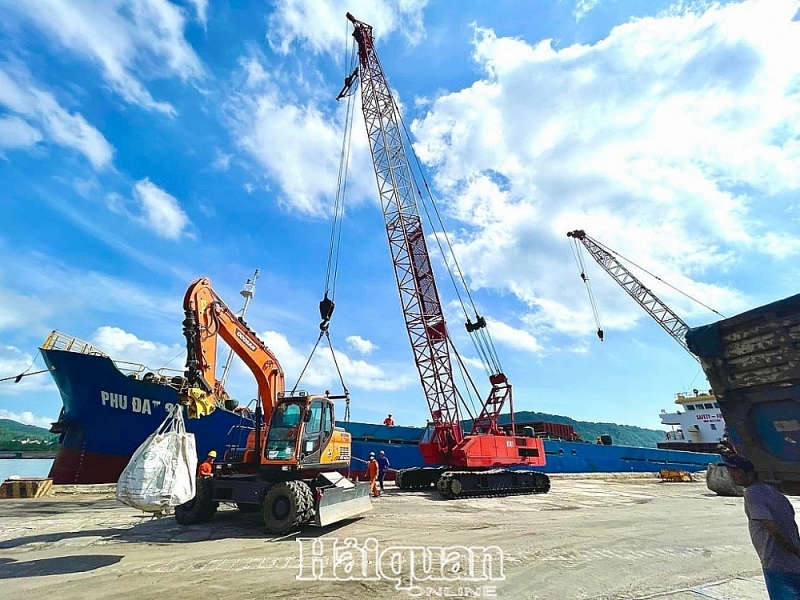Infrastructure capacity is increasingly being invested
Assessing Vietnam’s seaport system in recent years, Deputy Minister of Transport Nguyen Xuan Sang affirmed that, after 20 years of developing seaport infrastructure according to planning, Vietnam’s seaport system has determined that the model has a total length of over 90km, full loading and unloading functions with a throughput capacity of about 750 million tons/year. Up to now, Vietnam’s seaports have been invested with many large and modern ports with high exploitation productivity equivalent to seaports in the region and the world.
Major seaports across the country have invested, upgraded, and fundamentally improved their capacity and service quality to ensure the reception of ships from over 30,000 to hundreds of thousands of tons, such as the port in Ba Ria – Vung Tau. As a result, the ship has received over 214,000 tons (over 18,000Teus); Hai Phong seaport at Lach Huyen receives ships of up to 145,000 tons (capacity of about 13,500 Teu).
Mr Le Tan Dat, Deputy General Director of Consulting and Construction Joint Stock Company of Maritime Works (TVH), said that as of October 2022, the whole country has 296 wharves/about 103 km in length, more than 4.7 times in 2000. In addition, international gateway ports have been established in the northern and southern regions; they successfully received container ships up to 132,000 DWT at Lach Huyen Wharf (Hai Phong), up to 214,000 DWT at Cai Mep Wharf (Ba Ria – Vung Tau).
In addition, large-scale specialized wharves associated with industrial parks, metallurgical complexes, refineries and petrochemicals, coal-fired power centres receive ships up to 200,000 DWT, liquid cargo up to 150,000 DWT (product ships), crude oil to 320,000 DWT, has achieved the planning targets by 2020.
Currently, the whole country has put into operation 45 public navigational channels, 11 specialized navigational channels, 94 lighthouses and 32 information stations stretching from Mong Cai to Ha Tien with a system of reception, transmission, supply and distribution. In addition, provide identification and position tracking information for ships and boats (LRIT) and VTS systems installed at significant seaports to effectively support the management and monitoring of ships’ positions; supervise and manage second-line activities in seaport waters.
“It is expected that the total investment demand for the seaport system will be VND 398,706 billion in the coming period. By 2025, it will be VND 147,164 billion, including the need for investment capital for public maritime infrastructure and the need for investment capital for the port; by 2030, an additional VND 251,542 billion will be added,” added Mr Le Tan Dat.
 |
| Major seaports across the country have invested, upgraded, and fundamentally improved their capacity and service quality to ensure the reception of ships from over 30,000 to hundreds of thousands of tons. Photo: H.Dịu |
Consider investing in the form of PPP
As a type of development later than seaports, now inland ports are also gradually being invested in areas, and transport corridors with large volumes of container cargo, such as Mong Cai – Quang Ninh, Dinh Vu. – Hai Phong, Que Vo – Bac Ninh, Gia Lam – Hanoi, Duy Tien – Ha Nam, Nhon Trach – Dong Nai… The above-mentioned dry ports have made a very important contribution to the organization of the transport network, taking advantage of the particular efficiency and the transportation strength of each region, especially the inland waterway transport network, to transport goods with large volume, low cost and low pollution.
According to Mr Pham Hoai Chung, Institute of Strategy and Transport Development, up to now, the country has invested, announced and put into operation 10 dry ports. In addition, there are 6 inland customs clearance ports (ICDs) operating in the planned inland ports, but the investors have not yet carried out the procedures to convert them into inland ports according to regulations.
Inland ports and ICDs are mainly distributed on 5 corridors and economic areas out of 15 corridors, and economic zones with inland port planning, of which 4 coastal economic corridors in the North have been formed in total 5 inland ports are planned.
The total volume of goods imported and exported by container through inland ports and inland clearance points (ICD) currently operates about 4.2 million TEUs/year, of which 90% of goods go through customs ports. Inland (ICD) ports, including 6 ICD ports that have been planned to become inland ports and the whole cluster of ICD Truong Tho ports, Ho Chi Minh City… In particular, the cargo volume through 10 announced inland ports only accounts for about 10 % because most of these are newly formed and located in the North, except for the Tan Cang Nhon Trach dry port in Dong Nai.
To develop the inland port system in the future, Mr Pham Hoai Chung proposed to consider investing in inland port development in the form of public-private partnership (PPP) with large-scale inland ports in the direction of the state. As a result, the country creates favorable to complete the legal environment and promulgates mechanisms and policies for inland port development
At the same time, the planning for the development of the inland port system needs to be associated with the planning for the development of specialized transport by rail, road, sea, inland waterway and airway, especially planning to develop the seaport system to ensure uniformity and efficiency in the implementation of the plan.
